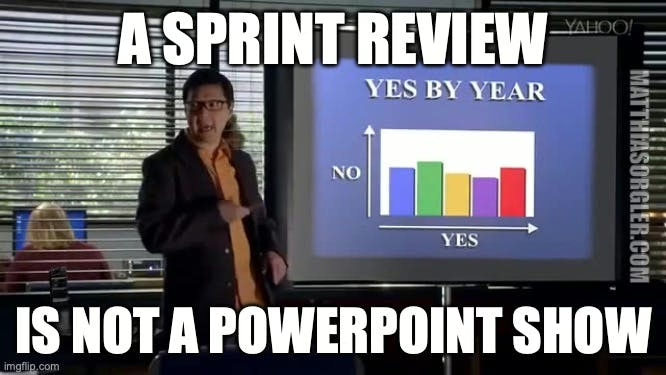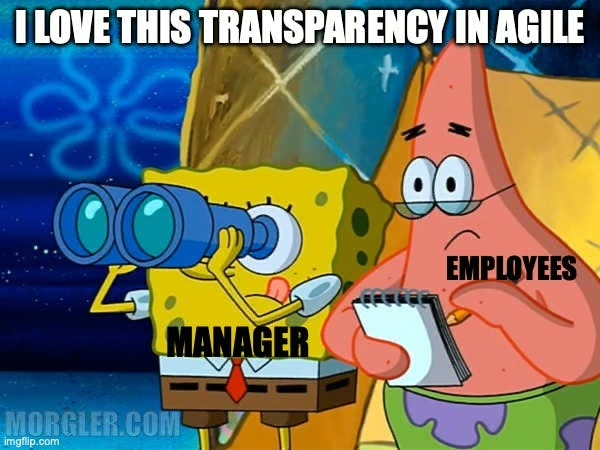Imagine working in a place where “transparency” means your every move is tracked. Feels more like a surveillance state than an agile workplace, right? ?
When Transparency Gets Twisted

Micromanagement Disguised as Openness
Some companies think that being transparent is all about monitoring employee performance down to the last minute. They track how many story points each person completes, turning teamwork into a solo race. It’s like measuring how many times each player touches the ball in soccer rather than focusing on winning the game together. Not cool! ⚽️
Real-Life Example: The Velocity Trap

I once saw a company measure velocity per person instead of per team. It led to people hoarding tasks and ignoring each other. Those who helped others or facilitated teamwork were penalized because it lowered their “personal velocity.” Talk about missing the point! Let’s not repeat that mistake.
See also Unlock Agile Velocity: Boost Your Team and Avoid Costly Mistakes
The Myth of the “Transparent” Employee
Ever heard of employees being treated as fully calculable units? Counting FTEs, logging work hours, and firing so-called “low performers” under the guise of transparency? That’s not transparency; that’s old-school control freakery. It’s Frederick Winslow Taylor with a digital clipboard! ?

What True Transparency Looks Like
Sharing Company Goals Loud and Clear
Transparency means everyone knows where the ship is headed. If your team doesn’t know the company’s goals, how can they steer in the right direction? Communicate those goals clearly, and watch your team’s engagement soar! ?
See also Unlocking Performance: The Overlooked Management Strategy That Works Wonders
Open Access to Business Data
Trust your employees with relevant business data—yes, even revenue figures and customer stats. Hoarding this information is like playing poker with your own team. Plus, some managers keep data close to maintain power. Time to break that cycle! ?
Embracing a Healthy Failure Culture
Mistakes happen. In fact, they should happen! A culture that welcomes admitting mistakes is a breeding ground for innovation. When your team isn’t afraid to fail, they’re more likely to take the risks that lead to big rewards. Fail fast, learn faster! ?
See also Rapid Experiments vs. Big Upfront Planning
The Power of Owning Up
Encouraging your team to openly admit mistakes can save projects from disaster. When issues are brought to light early, you can course-correct before small problems become big ones. It’s like fixing a leaky faucet before it floods the house. ?
Measuring Real Progress
Forget about tracking tasks completed or hours logged. The true measure of progress is a working product that delivers value to customers. Don’t fool yourself with vanity metrics; focus on what really moves the needle. ?
Working Product Over PowerPoints

Relying on overly thorough documentation and fancy slides can mask the reality of your project’s progress. The working product tells the real story. Let’s keep our eyes on the prize.
Clear Definition of “Done”
Ever had a project that’s “almost done” for weeks? Yeah, we’ve all been there. Establish a common understanding of what “done” means to avoid hidden work piling up. Integration, testing, refactoring—they all count! Let’s keep it transparent. ✅
Avoiding the Hidden Work Pitfall
Unaddressed tasks like integration and testing can lead to delays and problems down the line. By being transparent about what’s truly “done,” you prevent these hidden pitfalls from derailing your project.
How to Foster True Transparency
Build Trust Through Information Sharing
Transparency requires trust. Share information freely, and trust your team to use it wisely. Holding back data creates suspicion and stifles initiative. Remember, intransparency is so last century! ?
Empowered Teams Make Better Decisions
When employees have access to business data, they’re better equipped to make decisions that align with company goals. This accelerates decision-making and drives agile processes forward.
Focus on Team, Not Individual, Performance
Judge performance at the team level. When you pit individuals against each other by tracking personal metrics like velocity, you kill collaboration. Success is a team sport! ?
Collaboration Over Competition
By emphasizing team achievements over individual stats, you encourage a collaborative environment where everyone supports each other. This leads to better outcomes and a more positive workplace.
Seek Out Failure (Seriously!)
Encourage your team to seek failure. Sounds odd, but when people are unafraid to admit mistakes, you can correct course early and avoid bigger pitfalls down the line. It’s like having a built-in GPS for your projects. ?
Innovate Through Experimentation
When failure is accepted—even celebrated—your team feels safe to experiment. This leads to innovative solutions that can set your company apart from the competition.
Empower Employees with Business Insights
Don’t underestimate your team’s ability to understand and utilize business data. When employees grasp the bigger picture, they make better, faster decisions that benefit the product and the company. Knowledge isn’t just power; it’s progress. ?
Breaking Down Information Silos
Sharing data across teams eliminates silos and promotes a unified approach to achieving company goals. It’s all about moving forward together.
Set and Communicate Clear Goals

Unclear or conflicting goals are like trying to navigate in a fog. Set clear, achievable goals and make sure everyone understands them. This alignment is a leadership responsibility and a cornerstone of true transparency. ?
The Leadership Challenge
As a leader, it’s your job to ensure that goals are not just set but also clearly communicated. This provides direction and purpose, motivating your team to give their best.
Conclusion
Transparency isn’t a tool for micromanagement; it’s a catalyst for trust, innovation, and true agile transformation. Let’s stop abusing the term to control and mistrust our teams. Instead, let’s embrace transparency as our weapon against a VUCA (Volatile, Uncertain, Complex, Ambiguous) world. ?
By fostering a culture of trust, focusing on team success, and embracing failure, we can harness the real power of transparency. So let’s flip the script and make transparency work for us, not against us.
Ready to make transparency work for you?
- Dive into my Agile Games Collection for interactive ways to bring these concepts to life! ?
- Join the ACE Program, a masterclass designed to help agile coaches and scrum masters make agility truly effective in their organizations. ?
Let’s transform the way we think about transparency and make our workplaces not just more agil, but more human.

